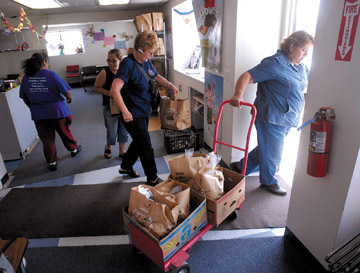
San Benito County tops state average
Rising unemployment in San Benito County has pushed some
formerly middle and working class residents to seek food stamps and
other assistance.
San Benito County tops state average
Rising unemployment in San Benito County has pushed some formerly middle and working class residents to seek food stamps and other assistance.
Unemployment in the county was 36 percent higher in March than it was a year ago, and is 5 percent higher than the state average.
Irais, a 28-year-old resident, who asked us not to use her last name, is on food stamps for the first time.
“That’s how hard it’s gotten,” Irais said.
She has not been able to find steady employment since she was laid off from a job as a cashier at a Quik Stop more than a year ago.
“I’ve worked, but the thing is, they say, ‘We don’t need you anymore,'” Irais said. “I say why, and they say, ‘because it’s slow.'”
Recently, she was laid off from a gas station cashier job at a Valero station, Irais said.
“The thing is, I’m not just sitting at home saying, ‘job, come to me,'” Irais said. “Everyday I’m looking. The good thing is I have a car and I can travel.”
Without steady employment, life is stressful, and everything is getting more expensive.
“Food is going up,” Irais said. “Gas is going up.”
Still, Irais is positive and has thought about going to school to study criminal justice.
“I’m going to try also going to school,” Irais said. “So even if I don’t find a job, I’ll have something. It’ll get better. I know it will.”
Like Irais, 3,000 residents of San Benito County were unemployed in March.
Historically, Hollister has had higher levels of unemployment than the rest of California during the winter months, said Jeff Pyle, Hollister’s economic development manager.
Seasonal workers are out of work during the winter. Unemployment tends to go down during the summer months when the fields are ready.
Community Pantry staff, a nonprofit that distributes food to families in San Benito County, are serving more people, said Mary Anne Hughes, director of the Community Pantry.
“Over the last year, since we moved here, we have gone up 60 percent,” Hughes said, referring to distribution.
In April, 1,062 families picked up food, more than 300 additional families from the month before.
Many of the new clients are unemployed.
“I have one lady who is a client that used to be a donor,” Hughes said. “It’s amazing how fast it can happen because most of us do not have that much in savings.”
In an economic downturn, lower-paid employees suffer, Hughes said.
“It’s not like you have a big manufacturing company that just laid off 400 people,” Hughes said. “A lot of it was this slow, creeping thing.”
Due to the slow housing market and the moratorium, some projects in Hollister are on hold.
New housing projects are not being built so local contractors have cut back on staff, Hughes said.
“You have a lot of carpenters, laborers and electricians who are not working,” Hughes said. “When you have to cut back, you may have enough work to support yourself and your family, but you cut back on everybody else.”
Unemployment can be particularly difficult for those who are not used to being in need of assistance.
“It’s a culture shock,” Hughes said. “It’s hard on family relationships. Especially when you look around and there are no jobs.”
People on the bottom are suffering most, Hughes said.
People who used to work for $30 per hour are willing to work for $20 per hour, Hughes said, and minimum wage earners are being forced out.
County residents receiving food stamps rose between July 2007 and March 2008.
Health and Human Services staff provide services for the unemployed, such as processing applications for food stamps and cash aid.
“We’ve seen an increase in new people who have never been in the system,” said Susan Petree, an integrated caseworker for San Benito County’s department of Health and Human Services.
Some people who have not needed assistance for the past few years are back in the system, Petree said.
To help people find work, staff provide services such as childcare assistance.
“We started the program 10 years ago,” Petree said. “People were getting out there and were able to find stuff, and it’s getting harder and harder. Places aren’t hiring as much as they used to.”









